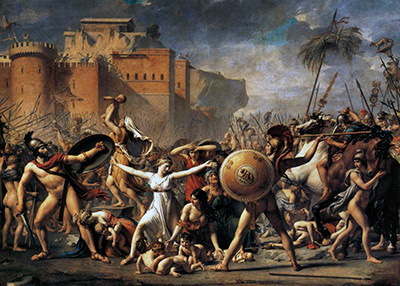This painting by David is a definition of a classic that came into conception during his time in prison in 1975 in the Luxembourg Palace and it still remains an object of numerous artistic representation.
This painting was based on the Sabins, who are the people who found dwelling in central Italy and the legend having it that Romulus wanted to get women but was faced with resistance as an army was raised and that is where the painter found his inspiration.
Location
In the foreground, the painter lets the view unfold to the viewer’s eyes with images of the two combatants bearing weapons in their hands ready to battle it out and between them there is woman fighting to separate them with children at the interpose.
The Focal Point
The point of view for this masterpiece is at the foreground at the point at which the two combatants are standing. A closer look and you will notice the woman separating them and further realizing that there are little children in the picture too. The Sabin woman is the isolates th two points of interest in the painting and the harmony of colours indicates that the light comes from the right-hand side of the painting.
Approach
David made use of a 17ft long canvas to come up with this masterpiece. He decided to make use of extra-long canvas so that he could profoundly capture the Greek masters style of art "...the most prominent general characteristics of the Greek masterpieces are a noble simplicity and silent greatness in pose as well as in expression..." This painting was supposed to be transition from Roman severe style of painting to newer from of pictorial manifesto. He utilised some theories from Johann Winclemann on his way of idealising beauty in his works. He achieved the intricate brushworks in the painting by opting to use frieze-like compositions that had seemingly minimal spatial depth, which was effective in bringing fourth predominance of colour I simplified schemes in a uniform light.
Inspirations and Influences
David was a quintessential painter in the Neoclassical era and his canvases remain a victory in the traditional history painting by achieving to blend Greco-Roman style with Enlightenment philosophy. This and many more of his artistic attributes inspired and influenced by his great works. Some of the names in the art industry that David influenced include Jean-Germain Drouais, Théodore Géricault, Anne-Louis Girodet, Jean-Auguste-Dominique Ingres and Yue Minjun. He also had a great influence on Romanticism and Neoclassicism.
Even with his incredibly intricate brushworks, David derived great inspiration from other artists who influenced his styles of art. Some of them include Peter Paul Rubens, Caravaggio, Raphael and Nicolas Poussin and styles like The Rococo, Classical Art and Neoclassicism greatly influenced how he approached his art pieces.




